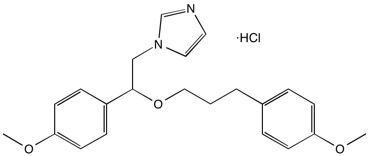SKF-96365 | TRPC channel blocker
NMR (Conforms)

Available Options
| Size: | Price | Quantity | |
|---|---|---|---|
| 5 mg | $65.00 | ||
| 25 mg | $260.00 |
SKF-96365 (130495-35-1) is an inhibitor of receptor-mediated calcium entry (RMCE) with IC50‘s of 8.5 μM for ADP stimulated platelets and 11.7 μM for thrombin stimulated platelets. Also inhibits Voltage-gated Ca2+ but not ATP-gated Ca2+ entry.1 It has also been shown to block transient receptor potential canonical type (TRPC) channels2, high-voltage-activated (HVA) L-type channels1, K channels3, sarcoplasmic reticulum Ca-ATPase4 and voltage-gated sodium channels5. SKF-96365 is a potent blocker of LVA T-type Ca channels, in particular Ca(V)3.1 (IC50 = 0.56 μM).6
References/Citations:
1) Merritt et al.,(1990) SKF96365, a novel inhibitor of receptor-mediated calcium entry; Biochem. J. 271 515
2) Kiselyov et al., (1998) Functional interaction between InsP3 receptors and store-operated Htrp3 channels; Nature, 396 478
3) Schwarz et al., (1994) Multiple effects of SKF96365 on ionic currents and intracellular calcium in human endothelial cells; Cell Calcium, 15 45
4) Mason et al., (1993) Inhibition of Ca2+ transport pathways in thymic lymphocytes by econazole, miconazole and SKF96365; Am. J. Physiol., 264 C654
5) Hong et al. (1994) Inhibition of the sodium channel by SKF96365, an inhibitor of the receptor-operated calcium channel, in mouse diaphragm; J. Biomed. Sci., 1 172
6) Singh et al.,(2010) The transient receptor potential channel antagonist SKF96365 is a potent blocker of low-voltage-activated T-type calcium channels; Br. J. Pharmacol., 160 1464
NMR (Conforms)
Safety Data Sheet:
Product Data Sheet:
Materials provided by Focus Biomolecules are for laboratory research use only and are not intended for human or veterinary applications. Please note that we do not sell to individuals and that all orders placed by non-research organizations will incur a $20 restocking/refund fee
SKF-96365 (130495-35-1) is an inhibitor of receptor-mediated calcium entry (RMCE) with IC50‘s of 8.5 μM for ADP stimulated platelets and 11.7 μM for thrombin stimulated platelets. Also inhibits Voltage-gated Ca2+ but not ATP-gated Ca2+ entry.1 It has also been shown to block transient receptor potential canonical type (TRPC) channels2, high-voltage-activated (HVA) L-type channels1, K channels3, sarcoplasmic reticulum Ca-ATPase4 and voltage-gated sodium channels5. SKF-96365 is a potent blocker of LVA T-type Ca channels, in particular Ca(V)3.1 (IC50 = 0.56 μM).6
References/Citations:
1) Merritt et al.,(1990) SKF96365, a novel inhibitor of receptor-mediated calcium entry; Biochem. J. 271 515
2) Kiselyov et al., (1998) Functional interaction between InsP3 receptors and store-operated Htrp3 channels; Nature, 396 478
3) Schwarz et al., (1994) Multiple effects of SKF96365 on ionic currents and intracellular calcium in human endothelial cells; Cell Calcium, 15 45
4) Mason et al., (1993) Inhibition of Ca2+ transport pathways in thymic lymphocytes by econazole, miconazole and SKF96365; Am. J. Physiol., 264 C654
5) Hong et al. (1994) Inhibition of the sodium channel by SKF96365, an inhibitor of the receptor-operated calcium channel, in mouse diaphragm; J. Biomed. Sci., 1 172
6) Singh et al.,(2010) The transient receptor potential channel antagonist SKF96365 is a potent blocker of low-voltage-activated T-type calcium channels; Br. J. Pharmacol., 160 1464
Calculate the molar concentration, mass or volume in a solution.
Concentration × Volume × Molecular Weight = Mass
Focus Biomolecules • Plymouth Meeting, PA USA • 1-855-FOCUS21
Focus Biomolecules
Plymouth Meeting, PA USA
1-855-FOCUS21
Website Created by Advanta Advertising LLC.

